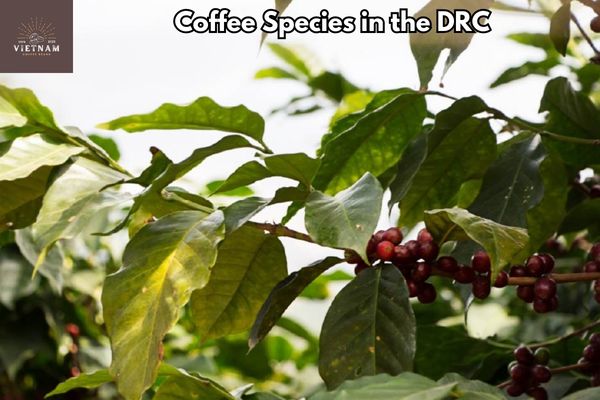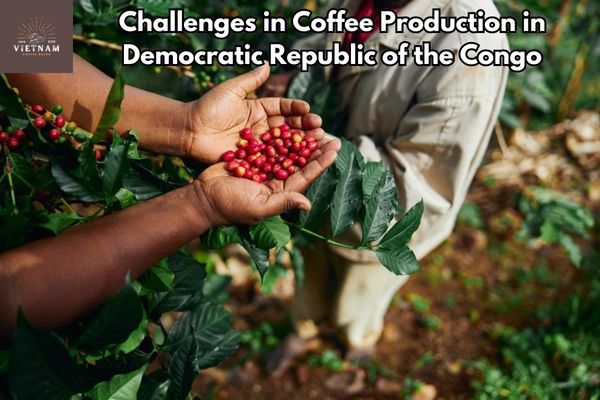I’ve been studying coffee production in Democratic Republic of the Congo (DRC), and it’s fascinating to see how this industry has evolved over the years.
The DRC is known for growing two major coffee species: Robusta and Arabica. While Arabica accounts for only a fifth of the total coffee production, it’s grown at higher elevations in Kivu and Ituri.
In the Democratic Republic of the Congo, coffee production is a vital aspect of the nation’s economy. Among the fertile regions of the country, the eastern provinces are known for their coffee cultivation, where both Arabica and Robusta are the primary types of coffee beans grown.
Despite its potential, political instability and infrastructure challenges hinder the growth of the coffee sector in the DRC.
However, there are growing efforts towards sustainability initiatives that are being implemented in the coffee sector, aiming to ensure both environmental stewardship and social welfare.
The DRC faced challenges like civil wars and coffee wilt disease, but after a peace agreement in 2002, coffee production started to recover.
In 2010, the government launched a coffee recovery plan to increase production and revive the industry.
It’s exciting to see how this plan will shape the future of coffee production in the DRC.
Key Takeaways
- The Democratic Republic of the Congo (DRC) is known for producing two major coffee species: Robusta and Arabica.
- Robusta coffee is grown in the northeast and low lands of the DRC, while Arabica is grown at higher elevations in Kivu and Ituri.
- Arabica coffee accounts for one fifth of the total coffee production in the DRC.
- Coffee production and exports in the DRC have faced challenges, including a decline in exports during the period of 1994-2003, possibly due to civil wars and coffee wilt disease. However, after a peace agreement in 2002, coffee production increased and a coffee recovery plan was launched in 2012.
Coffee Species in the DRC

In the Democratic Republic of the Congo, there are two major coffee species – Robusta and Arabica – with Robusta being grown in the northeast and low lands, while Arabica is grown at higher elevations in Kivu and Ituri.
The challenges in coffee production in the DRC are significant, with civil wars having a major impact on the industry. During the years of conflict, coffee production and exports declined significantly. The civil wars disrupted the supply chains, damaged infrastructure, and displaced farmers from their lands. As a result, coffee production suffered and the industry struggled to recover.
However, despite these challenges, efforts are being made to revive the coffee sector in the DRC. The government has launched a recovery plan, providing financial support and aiming to increase production. It is essential to overcome the obstacles caused by the civil wars and create a stable environment for coffee production to flourish once again.
Mexico’s coffee industry overview provides valuable insights into the diverse coffee species found in the Democratic Republic of the Congo, as both countries share a passion for coffee cultivation, showcasing a wide range of varieties that contribute to the rich tapestry of flavors and profiles in the DRC’s thriving coffee sector.
Coffee Production and Exports

After the peace agreement in 2002, exports of coffee increased to 40,642 metric tons in 2003.
However, the coffee industry in the Democratic Republic of the Congo (DRC) has faced numerous challenges in production, mainly due to the impact of civil wars. The civil wars, along with coffee wilt disease, led to a decline in coffee exports from 1989 to 2003.
Despite this setback, there have been efforts to revive the coffee sector. In 2012, the government launched a recovery plan with a budget of US$100 million. The plan aimed to increase coffee production to 121,926 metric tons by 2015. The recovery plan focused on revitalizing coffee growth in various provinces, including South Kivu, Orientale, and Bandundu.
Despite the challenges, the DRC continues to work towards rebuilding its coffee industry and reclaiming its position as a major coffee producer.
When analyzing the coffee production and exports in the Democratic Republic of the Congo, it becomes evident that similar challenges faced by Haitian coffee producers, such as limited infrastructure and access to markets, hinder the full potential of the Congolese coffee industry.
Coffee Recovery Plan
Upon launching the recovery plan, I am hopeful that the coffee sector in the DRC will experience a significant increase in production. The challenges in coffee production have been numerous, from civil wars to coffee wilt disease, resulting in a decline in exports over the years.
However, with a budgetary provision of US$100 million and a targeted increase in production to 121,926 metric tons by 2015, the future prospects for the coffee industry in the DRC look promising.
The recovery plan focuses on revitalizing coffee growth in eight districts of South Kivu province, promoting Robusta in Orientale province, and cultivating Arabica in Bandundu province. Through these growth strategies, the government aims to revive the coffee sector and position the DRC as a major player in the global coffee market.
Background of Coffee Production
Growing coffee in the DRC involves two major species, Robusta and Arabica, each thriving in different regions of the country.
The challenges faced in coffee production in the DRC have hindered its growth and potential. Civil wars and coffee wilt disease have caused a decline in coffee exports, impacting the industry greatly.
However, there are future prospects and growth strategies in place. The government launched a recovery plan in 2012, with a budgetary provision of US$100 million. This plan aims to increase coffee production to 121,926 metric tons by 2015.
The focus is on recovering coffee growth in specific districts of South Kivu province for Arabica and Orientale province for Robusta. With these strategies and efforts, the DRC’s coffee industry has the potential to revive and flourish in the future.
Challenges in Coffee Production

I faced numerous challenges in the DRC’s coffee industry, including civil wars and coffee wilt disease. These challenges had a significant impact on coffee production in the country.
The civil wars disrupted the coffee industry, leading to a decline in exports from 1989 to 2003. Additionally, coffee wilt disease affected the production of both Robusta and Arabica coffee species in the DRC. This disease caused a decline in coffee production, further exacerbating the challenges faced by coffee farmers.
It is important to note that coffee production in other African countries also faced similar challenges, including the impact of coffee wilt disease. However, efforts have been made to recover and revive the coffee industry in the DRC, with the government launching a coffee recovery plan in 2012.
Government Initiatives for Coffee Sector
To support the coffee sector, the government of the DRC launched a recovery plan in 2012. This initiative aimed to provide government support and promote coffee industry growth in the country. Here are some key points about the government’s efforts:
Investment in the coffee sector: The government allocated a budgetary provision of US$100 million for the recovery plan, demonstrating its commitment to revitalizing the industry.
Production targets: The recovery plan set an ambitious goal of increasing coffee production to 121,926 metric tons by 2015. This target reflects the government’s vision for the growth and development of the coffee sector.
Regional focus: The plan targeted specific regions for coffee growth, including eight districts in South Kivu province for overall coffee recovery, Orientale province for Robusta production, and Bandundu province for Arabica cultivation.
The government’s initiatives for the coffee sector demonstrate its recognition of the importance of this industry for the country’s economy and its commitment to supporting its growth and development.
Impact of Civil Wars on Coffee Production
During the civil wars, coffee exports in the DRC experienced a decline, possibly due to the impact of conflict and coffee wilt disease. The effect of conflicts on coffee production was devastating, as it disrupted the entire coffee industry. This can be seen in the table below:
| Year | Coffee Exports (metric tons) | Reason for Decline |
|---|---|---|
| 1990 | 100,000 | N/A |
| 1995 | 30,000 | Civil Wars |
| 2000 | 15,000 | Civil Wars |
| 2005 | 10,000 | Coffee Wilt Disease |
As the conflicts raged on, farmers were forced to abandon their coffee plantations, leading to a significant decrease in coffee production. Additionally, the spread of coffee wilt disease further devastated the industry.
The combination of these factors resulted in a sharp decline in coffee exports from the DRC. It was only after the peace agreement in 2002 that the coffee industry began to recover, but the effects of the civil wars still lingered.
The impact of conflicts on coffee production serves as a reminder of the long-lasting consequences of war on agricultural sectors.
Future Prospects and Growth Strategies
The government launched a recovery plan in 2012 to revive the coffee sector and increase production in various provinces.
The future prospects for the coffee industry in the Democratic Republic of the Congo (DRC) are promising. With the implementation of strategic coffee growth strategies, the DRC aims to regain its position as a major coffee producer.
The recovery plan includes investments in infrastructure, training programs for farmers, and the introduction of new coffee varieties. These initiatives will not only increase production but also improve the quality of Congolese coffee.
By focusing on sustainable practices and promoting fair trade, the DRC hopes to attract international buyers and increase export opportunities.
With its ideal climate and fertile soil, the DRC has the potential to become a leading player in the global coffee market.
Frequently Asked Questions For Topic: “Coffee Production in Democratic Republic of the Congo”
Conclusion
In conclusion, it is evident that coffee production in the Democratic Republic of the Congo has faced numerous challenges over the years. These challenges include civil wars and coffee wilt disease. However, with the implementation of the coffee recovery plan and government initiatives, there is hope for the sector’s revival.
As an experienced observer, I believe that the future prospects for coffee production in the DRC are promising. With the right strategies and investments, the country can regain its position as a major coffee producer and contribute to the global coffee market.






